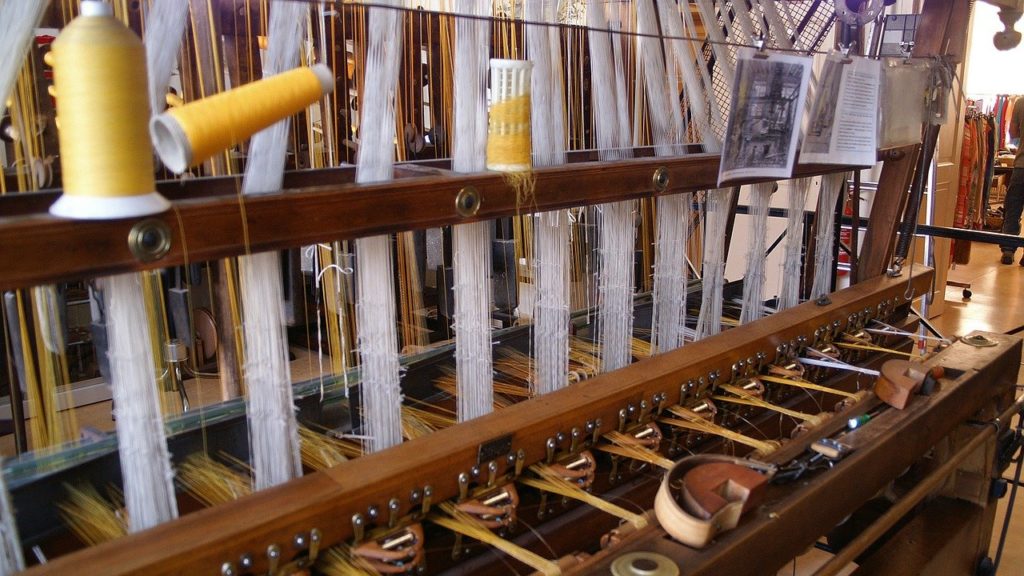Welcome to our second Pivotal Moments blog. If you follow us on social media, you’ll know what this is all about. To paraphrase Confucius, it’s only by knowing where we’ve been that we can know where we’re going. Today, we’re taking you way back.
“Study the past, if you would divine the future.”
Confucius
Joseph Marie Charles, known as Jacquard, might not be a name that springs to mind when you think of early computers. Particularly when you consider he was born in Lyon, France, way back in 1752.
In fact, Jacquard’s innovative engineering of the loom led to the technological revolution of the entire textile industry. And over a century and a half later, it was still influencing the development of modern computers.
Early Life
Joseph Marie Jacquard was the fifth of nine children. Though not formally educated, when his mother died in 1762, the family fell onto hard times. Soon, his father found him a place working as a bookbinder with an old clerk. However, when he displayed a talent for accounts and mechanics, the clerk advised Joseph’s father to place him somewhere he could put his skills to better use.
In 1772, Jacquard inherited his father’s workshop, looms and more assets than anyone had expected. Around 1778, Jacquard began to seek an improvement over the traditional drawloom. Despite having married the rich widow Claudine Boichon that year, he fell into debt after his poor investments went pear-shaped. By 1783, much of his money and property (including his wife’s) was gone. Jacquard was forced to take on odd jobs in other trades.
Returning to the silk weaving trade in the late 1780s, Jacquard developed his improvement on the drawloom. This version removed the need for a draw boy by automatically selecting draw warp threads. Though the adoption of his addition to the loom was slow, it was steady, and eventually spread through Lyon.

The Pivotal Moment
In 1800, Jacquard applied for his first patent for a treadle loom. Because of mechanical issues, this loom was unsuccessful, but it was enough to garner attention.
By 1801, Emperor Napoleon summoned the weaver to Paris to display his invention. Napoleon was so impressed with Jacquard’s innovativeness that he provided him with apartments in the Conservatoire des Arts et Metiers. Here, Jacquard had use of the workshop and was provided with an allowance that led him to further engineer his invention.
While at the Conservatoire, Jacquard saw on display an automated loom developed by Jacques Vaucanson. Though it had been mostly unsuccessful, the 50-year-old machine inspired Jacquard to change his own design.
Jacquard eliminated the paper strip used in Vaucanson’s mechanism. He returned to the use of punched cards as has been suggested by master silk weaver Jean Falcon in 1737. Jacquard developed an attachment that would fit many types of loom and allowed the weaving machine to create the delicate, complex patterns that are often seen in what’s now called Jacquard weaving.
In 1805, the Emperor viewed this loom and granted a patent to the city of Lyon. Despite French attempts to keep Jacquard’s technology secret, by 1812 there were around 11000 Jacquard looms in use across France. Soon, the innovation was beginning to turn up in other countries.
How Did He Do It?
By building on the work of other innovative loom designs and his engineering predecessors, Jacquard brought their ideas together to solve various practical problems – with the addition of his own insights.
He created an addition to the automatic loom that was quicker, more reliable and commercially viable than the already available drawlooms. This revolutionised the industry. Where previously it would take two men one day to produce an inch of decorated silk, his machine could produce two feet in the same time. And with only one weaver!
The loom attachment worked by using cards with punched holes, each of which corresponded to one row of the design. Using multiple rows of holes and hundreds of cards on an endless loop chain, they composed an intricate design which was woven into the fabric in a repeating pattern.
In essence, this is one of the earliest examples of a programmable machine.

Why is the Jacquard Loom Important Today?
The method of using punched cards to direct mechanisms was later used by mechanical engineer, Charles Babbage – the man considered to be “the father of the computer”.
He used a similar design to produce a calculator that is now viewed as the forerunner to today’s computer programming methods. You might have heard of it – his “Analytical Engine”.
What’s interesting is that, at the time, Jacquard’s loom was hugely unpopular. He was the subject of great hostility from the silk weavers of Lyon and France in general, who burned his machines and attacked their inventor. The silk weavers were worried that the machine’s labour-saving capabilities would put them out of work, removing the need for a human touch in the weaving industry.
Sound familiar?
Even today, with digital marketing and computers everywhere, touching all aspects of our lives, some are concerned that computers are taking over. That real people lose out on work because computers can do more than a human being, and faster.
What do you think? Is technology taking over? What’s going to be the next big thing?